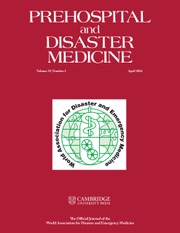Article contents
Emergency Medical Team Deployment in Response to Cyclones Judy and Kevin in Vanuatu: Coordination, Challenges, and Outcomes
Published online by Cambridge University Press: 21 May 2025
Abstract
In March 2023, Vanuatu faced severe impacts from twin tropical cyclones Judy and Kevin. This state of emergency necessitated the activation of the National Health Emergency Operations Centre (NHEOC) and the Emergency Medical Team Coordination Cell (EMTCC) to coordinate deployment of both national and international EMT responses.
The primary objectives were to provide life-saving services, ensure essential medical support, maintain minimum standards of healthcare, and improve coordination among the various health teams and sectors involved in the disaster response.
The EMTCC managed the deployment of over five National EMTs and four International EMTs. Reception and Departure Centers (RDCs) were set up at entry ports for team verification and briefing. Daily Minimum Data Set (MDS) reporting facilitated consistent monitoring and planning. The EMTCC coordinated logistics, transport, ration supplies, and implemented a medivac process for patient referrals.
Over five National EMTs, including medical officers, midwives, psychosocial support, logistics, and nurses, were deployed, serving at least 1,638 patients. RDCs efficiently processed international teams, and daily MDS reports supported informed decision-making. Collaboration with international partners was effective, and a medivac process ensured timely patient transfers. Despite logistical delays, financial constraints, and human resource shortages, the coordinated efforts led to significant positive outcomes.
The EMT deployment in Vanuatu highlighted the importance of well-coordinated emergency responses. Key lessons include the need for standardized tools and procedures, continuous training, improved financial processes, and stronger logistical arrangements. Future recommendations emphasize dedicated budgets, pre-positioned resources, clear SOPs, and enhanced coordination to improve EMT resilience and efficiency in disaster scenarios.
Information
- Type
- Meeting Abstracts
- Information
- Copyright
- © The Author(s), 2025. Published by Cambridge University Press on behalf of World Association for Disaster and Emergency Medicine


